Of all of the different paint mediums out there, many consider watercolor to be the most beautiful, illusive and mysterious. Any artist dabbling in watercolors for the first time will soon discover that it is a different beast than other types of painting. Watercolor paints are less about total control, and more about directing the flow of the color and the water. It’s easy to make mistakes, and it’s more difficult to cover them up (since you can’t just paint over them.) You layer your colors differently with watercolor, and employ different techniques.
For all of that, though, watercolor is actually a really rewarding and fun medium! With watercolors, you can create an effect of lightness and flow in your art that no other medium quite captures. For many artists, there’s also something really fun about the looseness of the medium, because the art that you create seems to have a little bit of a life of its own.
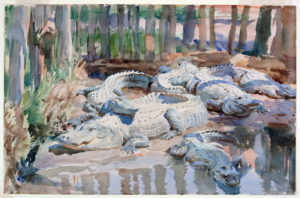
John Singer Sargent. “Muddy Alligators,” 1917. (Photo: Public Domain)
If you are thinking of trying out watercolor painting for the first time, don’t be scared. While it may be different from other types of painting, watercolor painting is beautiful and fun. It’s just something you have to play with a little bit to get comfortable! To help, here are 10 basic watercolor tips for beginners (of all ages) that will help get you started. Happy painting!
1.Use real watercolor paper.
When it comes to watercolor painting, paper makes all the difference in the world. Most of us probably remember those cheap watercolor booklets from very early childhood. You know, the ones that came with a little watercolor set and brush that you could use to paint the Disney illustrations on the coloring paper? While that was a fun way to spend a few minutes when you were five, those materials (especially the paper) won’t hold up when you’re really wanting to watercolor.
Nope, you need watercolor paper. Watercolor paper is heavier and it will absorb the paint and water. This is important for a couple of reasons. Firstly, regular paper literally won’t hold up once you start putting water on it (which means that your art will be destroyed). Secondly, the thickness and absorbency of watercolor paper will help direct the flow of the water and the paint.
And just because I’m telling you to spring for real watercolor paper doesn’t mean you have to buy the most expensive kind, especially when you are first getting started. There are definitely some very nice (and pricey) watercolor paper brands out there, but there are also some inexpensive brands that are ideal for someone who is just starting out with this medium. Some types of watercolor paper are smooth, and others are more rough. (I like watercolor paper that has a little bit of “tooth” –a gripping texture.) I’d suggest starting with a less expensive brand and moving up from there as you get more comfortable with watercolor painting!
2. Pick the right paint and brushes.
In addition to watercolor paper, you obviously need watercolor paint (which is what makes it watercolor, right?) You’ll also want brushes that are designated for watercolor (especially if you do other types of painting)! There is a huge amount of variety when it comes to different types of paint and brushes, so it’s important to find ones that work the best for you. Below are some tips and suggestions for choosing what you’ll need to get started.
Watercolor Brushes:
You don’t need to spend a ton of money, but you will want more than one shape or size brush for your watercolor endeavors (again, you are not looking to recreate those Disney watercolor booklets from your childhood).
Try starting with:
- a very small brush (for details)
- a large round brush
- a flat brush (for washes)
- a medium sized brush (any shape)
This will give you a good amount of diversity for a beginner! As you paint more, you can see what else you may want or need. Be sure to clean your brushes and let them dry after each painting session.
Watercolor Paints: Pans, Tubes and Watercolor Pencils
Watercolor paints come in many different types, price-points and colors! Two of the most common are pans and tubes. Watercolor pans offer a full range of color options in a portable little set that you can swirl your wet brush in to pick up color. Tubes are – well they are what they sound like! With tubes of watercolor paint, you can squeeze out a little bit of paint onto your own custom-made palette.
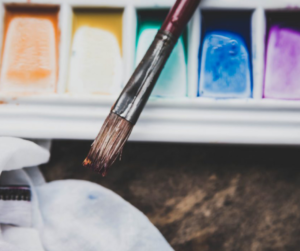
Both are good choices, depending on what you want. I personally like the portability and ease of using a watercolor pan set. I also think it’s probably the easiest method for the beginner who is interested in watercolors. Tube paints, however, offer richly pigmented colors and greater opacity. They are also ideal if you prefer working on large pieces because you can get more paint on your brush at one time. (Of course, you can also play around with using a mixture of both!)
Another option to consider is watercolor pencils. Watercolor pencils act like a regular colored pencils until you add water, and then they immediately get that “watercolor effect.” This can also be a good option for the beginning watercolorist because it offers more control and a higher level of detail than watercolor paint. The only con is that perhaps it doesn’t offer as much of the traditional “watercolor experience,” as paint does.
3. Play around first.
One of my favorite things about watercolor is how it is a little bit loose and has a mind of it’s own, which is something you’ll definitely come across as you play with watercolor paints!
Let go of the need to create super-detailed art. Don’t put any pressure on yourself to make a masterpiece. Just give yourself some time to play and see how watercolor paints blend and move on the water. See what happens to the colors when you mix them off the page versus on the page, or when you add different amounts of water. Play with blending different colors and adding a drop of water to see what happens! Playing with watercolors like this can be incredibly fun, and it doesn’t really matter if you come up with anything you want to keep.
Sparketh instructor, Amy, posts daily art tips and tricks on Sparketh’s TikTok channel. Recently, Amy shared an awesome idea for playing with watercolor by making random shapes and designs and going back in later with a pen to make visual connections and add details. This is a perfect idea for playing with watercolor, as it’s truly in the watercolor spirit of “going with the flow.”
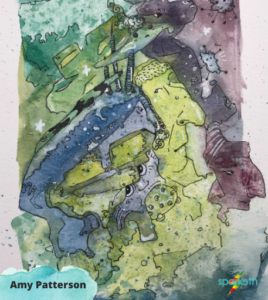
And you can watch the short video below to see how she did it!
@sparketh Have y’all tried this? What did your mind make you create?? #artistsoftiktok #myart #watercolor #artblock #arthelp #arttips
4. Experiment with basic techniques and textures
If you are a Sparketh member, this Sparketh course will show you several different watercolor techniques for beginners to try and talk you through different scenarios in which you might want to use each of them.
These include:
- Wet on wet technique
- Wet on dry technique
- Dry on dry technique
- Dry on wet technique
- Flat wash technique
- Gradient wash technique
The below example by student artist, Alyssa H., comes from the Sparketh student gallery and shows the techniques that this student experimented with in the basic watercolor techniques course.
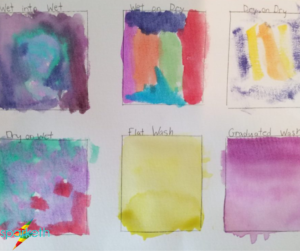
Salt-Resist Technique
Another technique that is really fun to try when you are getting started is to try creating a wet spread of paint over your watercolor paper and then sprinkle some salt on top! The salt will soak up the paint/pigment, and when your paint is dry you can brush off the salt crystals to reveal a really cool texture on your paper!
5. Start with a Light Sketch.
Starting out with a light pencil sketch is a great strategy to use with watercolor art. In addition to sketching out the details that will guide your painting, you may also want to designate areas of your painting that you want to leave white, keep light, or go darker with.
One of the things that a lot of people have trouble adjusting to with watercolor is the fact that you can’t just paint something white. If you want something in your painting to be white or a lighter-color, you have to leave it that way! And once there is a lot of pigment in a certain area, it’s there to stay.
Therefore it’s important to think about composition of your lights and darks before you start painting. Mapping this out with a sketch can be super helpful! Just be sure to follow the cardinal rule of sketching: keep it super light.
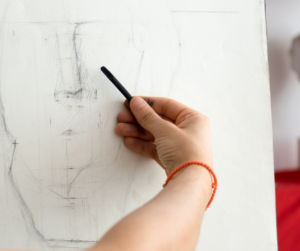
7. Work from Light to Dark.
This one goes hand-in-hand with the last point. In watercolor painting, you aren’t really able to undo, or paint over, color. Once your painting gets dark, adding more paint only makes it darker. That’s why one of the most important tips to keep in mind when working in watercolor is to work from light to dark.
Think about this as being similar to cooking. You can always add more salt to a recipe if you need it, but once you’ve added too much it’s hard to go back and fix your dish! The same principal applies to watercolor, so it’s important to start out light and layer on darker colors gradually.
If you’re just starting out with watercolors, this mindset may take a little getting used to. However, it is kind of a meditative and relaxing process once you get into it!
8. Have These Things Nearby
You can paint with watercolors as long as you have the brushes, paint and paper. However, you probably have these other supplies at home already, too, and they can help make your experience easier and more fun!
Paper towels
Definitely keep paper towels nearby when painting with watercolor. In addition to cleaning up accidental spills (it happens), they are the exception to the rule when it comes to fixing mistakes. If you put down color somewhere you didn’t mean to, you can add water and press the area with a paper towel to lift it in a hurry. You can also use a paper towel to clean your brush when switching colors.
A special glass jar or cup for painting
This one may seem obvious, but you’ll need a glass of water handy anytime you are painting with watercolors. It can be nice to have a designated cup or jar with your watercolor supplies at all times! You can empty it and store your brushes in it when you aren’t painting. I use a glass vintage cocktail shaker that belonged to my grandparents, and it always makes me smile!
Masking tape
There are (at least) two cool things you can do with masking tape and watercolor painting. Firstly, you can use 4 pieces of tape to create a boarder around your watercolor paper before you get started. This will hold your paper in place on your work surface, and it will also create a cool “frame effect” after you pull the tape off (when your painting is finished and completely dry). Secondly, you can “mask off” other parts of your paper that you want to leave white before you even start painting. Many art stores carry a masking fluid that you can also use to get this effect with a little more control, but masking tape is a great way to try this technique using something you probably already have at home.
9. Check out some of Sparketh’s online art classes and Social Media Resources
Sparketh is all about giving your child the best art education at home, so we want to be a resource that helps you learn more about whatever kind of art medium you are interested in! This includes watercolor, of course! We have several online watercolor classes that are perfect for beginners.
(If you are interested in starting a membership and getting access to online art classes, you can find out more, here!)
We also provide free art resources on a regular basis via our social media channels! The professional artists on our team offer art tips and support via our various channels on:
So be sure to follow Sparketh on social media (click any of the above links to go to that respective page)! It’s free, it’s fun, and it’s all about art! There are tips for working in every imaginable medium, including watercolor.
10. It may sound dumb, but trust me: it’s important…
You may think you don’t need this tip, but it is one of the most important things I can tell you about working with watercolors.
At some point, you will be drinking a beverage from a glass. You will think to yourself, “I’d like to do some watercolor painting.” You will get out your paints, paper, and brushes. You fill up a glass with water. You will take your beverage with you as you sit down and start painting.
After you’ve been painting for awhile, you will reach for your cup, take a drink.
It will be disgusting. You will realize you just drank paint water. It happens. It happens to us all.
My tip is two-fold:
1. You may want to switch to drinking from a water bottle while painting.
2. If it happens, consider yourself officially initiated into the world of watercolor.
I hope these basic watercolor tips help you get started in your watercolor journey! For more art tips and education, be sure to follow us on social media and check out Sparketh’s online art courses!


